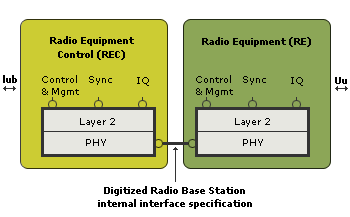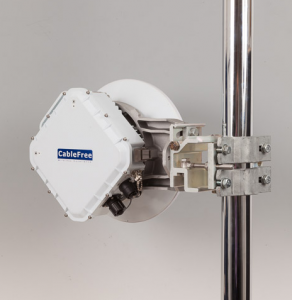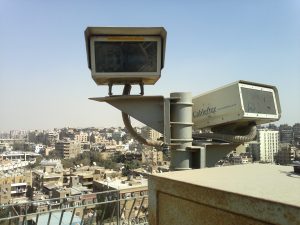CPRI Front-Haul Wireless Links for 4G, 5G & LTE Operators
The Common Public Radio Interface (CPRI) standard defines the interface of base stations between the Radio Equipment Controllers (REC) in the standard, to local or remote radio units, known as Radio Equipment (RE).

Traditionally, CPRI links are over Fibre Optic cables, which can be either:
- Short distances: Up/down the tower, from Baseband Unit in a cabinet typically located at the base of the tower, to Remote Radio Heads (RRH) at the top of tower/building.
- Longer distances: The BBU’s are located centrally in a “Base Station Hotel” location in a city, connected across the city using longer fibre links to RRH’s at the top of each tower/building.
CPRI bit rates:
CPRI bit rates are defined by the at www.cpri.info
| CPRI Line Rate | Line Bit Rate |
Line Coding |
Bits per word |
Transport capacity (#WCDMA AxC) |
Transport capacity (#20 MHz LTE AxC) |
|---|---|---|---|---|---|
| Rate-1 | 0.6144 Gbps | 8B/10B | 8 | 4 | – |
| Rate-2 | 1.2288 Gbps | 8B/10B | 16 | 8 | 1 |
| Rate-3 | 2.4576 Gbps | 8B/10B | 32 | 16 | 2 |
| Rate-4 | 3.0720 Gbps | 8B/10B | 40 | 20 | 2 |
| Rate-5 | 4.9152 Gbps | 8B/10B | 64 | 32 | 4 |
| Rate-6 | 6.1440 Gbps | 8B/10B | 80 | 40 | 5 |
| Rate-7A | 8.1100 Gbps | 64B/66B | 128 | 64 | 8 |
| Rate-7 | 9.8304 Gbps | 8B/10B | 128 | 64 | 8 |
| Rate-8 | 10.1376 Gbps | 64B/66B | 160 | 80 | 10 |
| Rate-9 | 12.1651 Gbps | 64B/66B | 192 | 96 | 12 |
| Rate-10 | 24.3302 Gbps | 64B/66B | 384 | 192 | 24 |
CPRI transports I/Q data of particular antennas and particular carriers. This “unit” is called an AxC unit or Antenna-Carrier unit. As an example:
In an LTE system, if I=16 bits and Q=16 bits then one AxC is of length 32 bits.
Future evolution to eCPRI
The CPRI standard is planned to evolve to eCPRI which runs over IP/Ethernet. The new specification will enhance the support for the 5G Front-haul by providing functionality to support CPRI (7.0) over Ethernet allowing for CPRI and eCPRI interworking.
Wireless-To-The-Antenna using CPRI

CableFree has pioneered the use of transparent uncompressed CPRI transport directly over wireless links at Nx 1.22Gbps to provide “Front Haul” from the remote antenna location to centralised base station infrastructure with distances up to 10 to 20km.
For Cellular 4G/5G/LTE operators, “Front Haul” links using CPRI are offered which allows remote positioning of the base station antennas, enhancing coverage and increasing flexibility of network deployment.
By using transparent connections, there is no latency or compression of the transmitted signal, which is identical in quality to traditional Fibre Optic connections, but with huge advantages in flexibility and speed of roll-out and deployment. Also, the CableFree CPRI units are significantly lower in latency than fibre due to two factors:
- Fibre Optics paths are never in a straight line – they travel round city blocks underground and around street corners, at street level, and then up the buildings in ducts or risers
- Wireless Propagation in air is around 40% faster than fibre optics, due to the Refractive Index of the fibre (glass) compared to air (nearly the same as a vacuum)
Wireless-To-The-Antenna (WTTA) as a complement to FTTA (Fibre to the Antenna)
CableFree have coined the term “Wireless to the Antenna” (WTTA) as a complement to the existing term “Fibre to the Antenna” (FTTA). FTTA architecture has enabled lower power requirements, distributed antenna sites, and a reduced base station footprint than conventional tower sites.

WTTA using transparent CPRI links operating at 1.22Gbps or 2.5Gbps means that the Remote Radio Heads can be located up to 10 or 20km away from the Base Station infrastructure, without requiring fibre optic cables, which can be expensive and difficult to lay. Usually, existing fibre runs are along city blocks at street level and do not go directly to the exact rooftop sites where the base stations are located. Conversely, Wireless “Front Haul” MMW or FSO units can be directly co-located along with the Base Station and Antenna infrastructure, and immediately deployed in minutes or just a few hours for permanent installations.
Connecting Remote Radio Heads

A remote radio head is a remote radio transceiver that connects to an operator radio control panel via electrical or wireless interface. When used to describe aircraft radio cockpit radio systems, this control panel is often called the radio head.
In wireless system technologies such as GSM, CDMA, UMTS, LTE this Radio equipment is remote to the BTS/NodeB/eNodeB, and is also called Remote Radio Head. These equipment will be used to extend the coverage of a BTS/NodeB/eNodeB like rural areas or tunnels. They are generally connected to the BTS/NodeB/eNodeB via a fiber optic cable using Common Public Radio Interface protocols.
Remote radio heads (RRHs) have become one of the most important subsystems of today’s new distributed base stations. The remote radio head contains the base station’s RF circuitry plus analog-to-digital/digital-to-analog converters and up/down converters. RRHs also have operation and management processing capabilities and a standardized optical interface to connect to the rest of the base station. This will be increasingly true as LTE and WiMAX are deployed. Remote radio heads make MIMO operation easier; they increase a base station’s efficiency and facilitate easier physical location for gap coverage problems.
CPRI bit rates Supported over Wireless
The CPRI standard allows for different bit rates. These are easy to achieve over fibre optics with today’s technology. However over wireless links, the capacity is more limited due to available spectrum, link margins, atmospherics and technology limits. The following are defined for CPRI:
• CPRI line bit rate option 1: 614.4 Mbit/s, 8B/10B line coding (1 x 491.52 x 10/8 Mbit/s)
• CPRI line bit rate option 2: 1228.8 Mbit/s, 8B/10B line coding (2 x 491.52 x 10/8 Mbit/s)
• CPRI line bit rate option 3: 2457.6 Mbit/s, 8B/10B line coding (4 x 491.52 x 10/8 Mbit/s)
• CPRI line bit rate option 4: 3072.0 Mbit/s, 8B/10B line coding (5 x 491.52 x 10/8 Mbit/s)
• CPRI line bit rate option 5: 4915.2 Mbit/s, 8B/10B line coding (8 x 491.52 x 10/8 Mbit/s)
• CPRI line bit rate option 6: 6144.0 Mbit/s, 8B/10B line coding (10 x 491.52 x 10/8 Mbit/s)
• CPRI line bit rate option 7: 9830.4 Mbit/s, 8B/10B line coding (16 x 491.52 x 10/8 Mbit/s)
• CPRI line bit rate option 8: 10137.6 Mbit/s, 64B/66B line coding (20 x 491.52 x 66/64 Mbit/s)
Note that generally bit rate options 1,2,3 are available over MMW, and 1,2 over FSO. These can be “aggregated” using 2+0 and higher (4+0, etc) links to provide higher capacities, for example where more LTE sectors are required.
Continuing Advances in MMW and FSO transmission will enable transport of higher CPRI line rates up to 10Gbps for example.
For More Information
For more information on CPRI links for 4G/5G/LTE infrastructure please Contact Us

You must be logged in to post a comment.